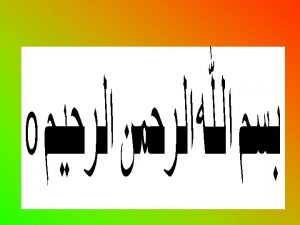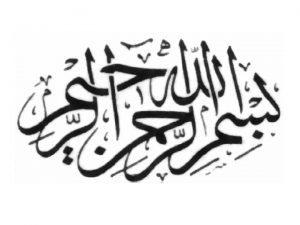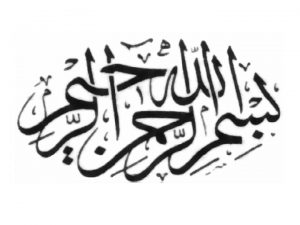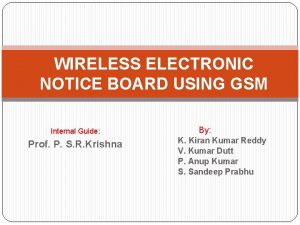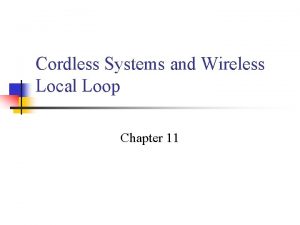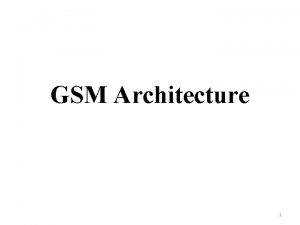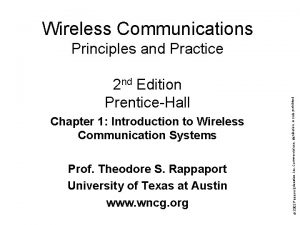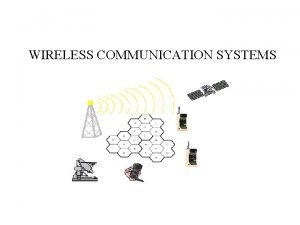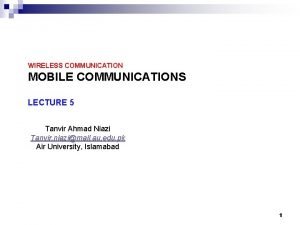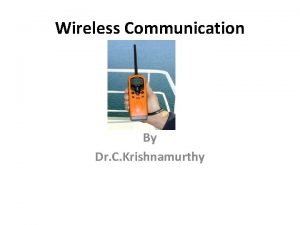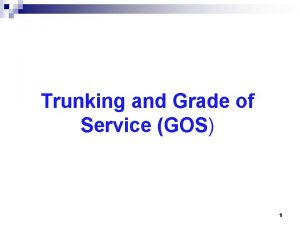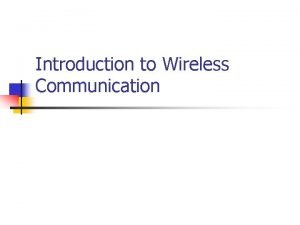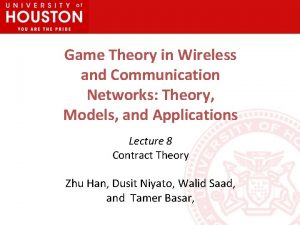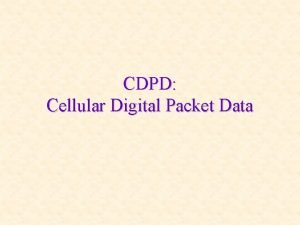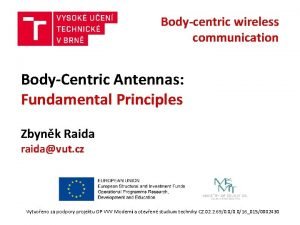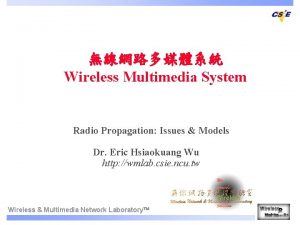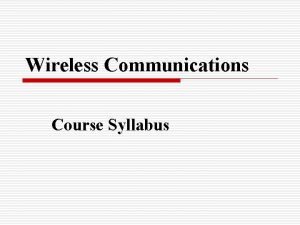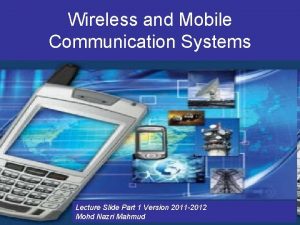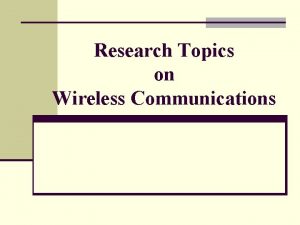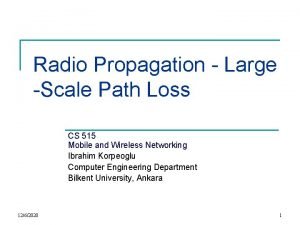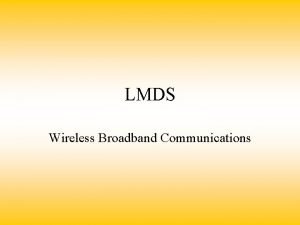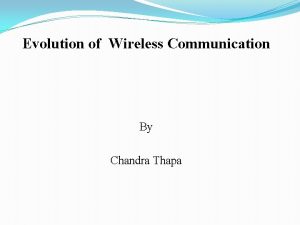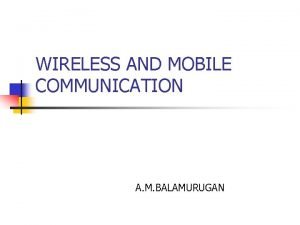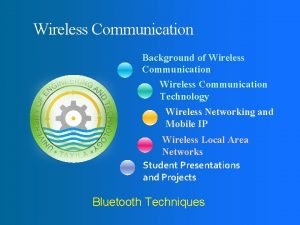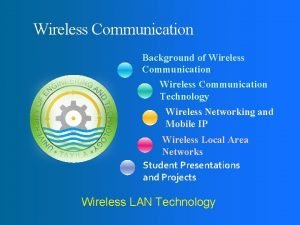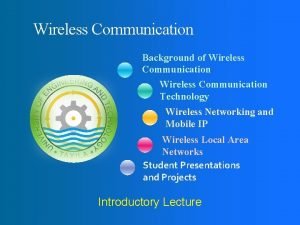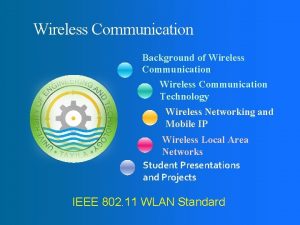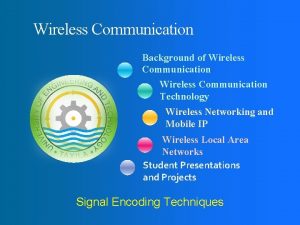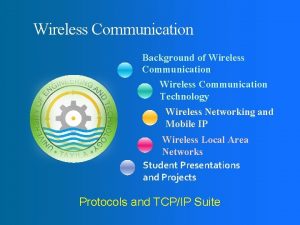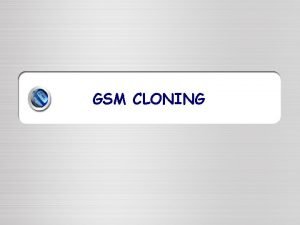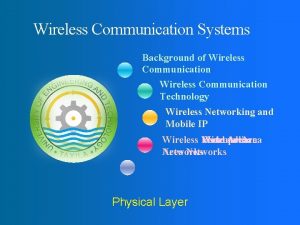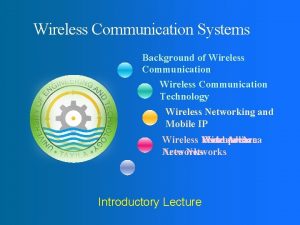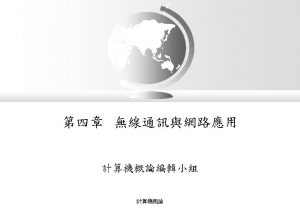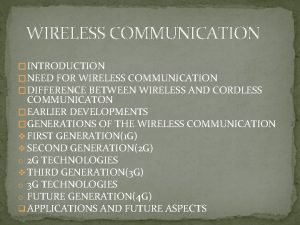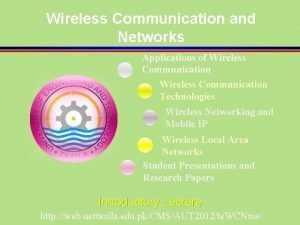Wireless Communication Systems GSM Dr Mustafa Shakir GSM
































- Slides: 32


Wireless Communication Systems GSM Dr. Mustafa Shakir

GSM Parameters Access method FDMA/TDMA Duplexing Method FDD Uplink (MS to BTS); Reverse link 890 to 915 MHz Downlink(BTS to MS); Forward link 935 to 960 MHz Channel Bandwidth 200 KHz No. of Timeslots / frame 8 Modulation GMSK Carrier Bit Rate 270. 8 Kbps 3

GSM Air Interface FDMA means that a given band is divided into 200 KHz carriers or RF channels in both the uplink and downlink directions TDMA means that multiple users share a given RF channel on a time-sharing basis FDD means that different frequencies are being used in the forward and reverse direction 4

GSM Frequency bands GSM 900 Uplink Downlink Extended GSM (E-GSM) 890 MHz 915 MHz 880 MHz- 935 MHz 960 MHz 925 MHz- 915 MHz 960 MHz DCS 1800 PCS 1900 1710 MHz 1785 MHz 1850 MHz 1910 MHz 1805 MHz 1880 MHz 1930 MHz 1990 MHz A guard band of 200 KHz is located at each end of each frequency band For example, in standard GSM 900, the first uplink RF channel is at 890. 2 MHz and last uplink RF channel is at 914. 8 MHz, allowing a total of 124 carriers 5

GSM Air Interface n n GSM systems can be implemented in any frequency band. However, several bands exist where GSM terminals are available. q q q The band 890 to 915 MHz has been allocated for the uplink direction (transmitting from the MS to the BS). Two frequency bands, 25 MHz in each one, have been` allocated by ETSI for the GSM system: The band 935 to 960 MHz has been allocated for the downlink direction (transmitting from the BS to the MS). 6

GSM Air Interface 7

GSM Air Interface n To give the maximum number of users access, each frequency band (25 MHz) is subdivided into 125 carrier frequencies spaced 200 k. Hz apart (called Absolute Radio Frequency Channel Number - ARFCN), using FDMA techniques. n The channel Bandwidth for GSM is 200 Khz. n For a Frequency band of 25 MHz • Total channel will be = 25 MHz/200 KHz • Total channel = 125 channels. 8

GSM Air Interface n Each base station is assigned one or more carriers to use in its cell. n In GSM the 1 st carrier frequency is used as a guard band between GSM and other services that might be working on lower frequencies. n A full duplex channel is assigned with the two separate frequencies (allotted in forward and reverse direction. ) in a 45 MHz separation. This enables the two way communications in a GSM network n 9

GSM Network Architecture 10

GSM uses paired radio channels IN UPL K K LIN N W DO 890 MHz 0 915 MHz 124 935 MHz 0 960 MHz 124 11

Multiple Access (Carrier Frequencies) 12

Multiple Access (Frame / Bursts) n GSM allows many users to use their cell phones at the same time. n GSM uses a combination of Time-Division Multiple Access (TDMA) and Frequency-Division Multiple Access (FDMA) to share the limited bandwidth (provided by regulators to the service providers ). FDMA divides the spectrum into small slices, and Each frequency slice is separated in time into many blocks by TDMA. n n TDMA allows many users to share a common channel. 13

Multiple Access (Frame / Bursts) n Frequency band is 25 MHz (up & down link) n The channel width is 200 KHz. n Each carrier frequency (RF) is then divided according to time using a TDMA scheme. n This gives 125 channels. 14

Multiple Access (Frame / Bursts) n Each of the carrier frequencies (RF) is divided into a 120 ms multiframe. n A “multiframe” is made up of 26 frames. n The duration of a frame is 4. 615 msec. 15

Multiple Access (Frame / Bursts) n 1 of the frames of one multiframe is used for control purpose and 1 is unused. n Remaining 24 frames are used for traffic. n TDMA frame consists of “ 8 Time slots” called “burst”. So their will be eight users in one TDMA Frame. n In a TDMA system, a burst is the unit of time. n Each frame lasts approximately 4. 62 ms, such that each time slot lasts approximately 0. 577 ms 16

Multiple Access (Frame / Bursts) 17

Multiple Access (Frame / Bursts) • After 4. 615 msec the user will again occupy the slot and since duration is too small, hence is not recognized by the user. • There are four types of packet bursts in GSM standard. • For each of these a particular structure has been designed. • The burst used for transporting call data (voice/data) is called a “Normal burst”. 18

Multiple Access (Frame / Bursts) FDMA/TDMA Bandwidth Burst Slot 0 Slot 1 Slot 2 Burst Burst Slot 3 Slot 4 Slot 5 Slot 6 Slot 7 F 1 0. 577 0. 577 200 k. Hz F 2 0. 577 0. 577 200 k. Hz F 3 0. 577 0. 577 200 k. Hz F 4 0. 577 0. 577 200 k. Hz 19 Time ms

Multiple Access (Frame / Bursts) Frames and Time slots v The structure of normal burst is 20

Multiple Access (Frame / Bursts) • • FLAG : 1 bit • Indicates whether user information or control information TRAIL bits : 3 bit • Used for synchronization. GUARD (Guard time) : 8. 25 bits (30. 5 sec) • Reduce interference to signals in nearby cells using the same carrier. During this period no data is sent. It is at the end of the burst. TRAIN (Training sequence) : 26 bits • Select the strongest signal in case of Multipath propagation Stealing bit Indicates whether this block contains data or is stolen for urgent control Signalling Encrypted Bits 114 cipher text bits of plain text bits (data) is placed in two 57 bit fields. 21

Multiple Access (Frame / Bursts) Frames and Time slots • • • Each burst contains 156. 25 bits, while user data is further divided into two blocks of 57 bits i. e. it is 114 bits. As multiframe is Containing 26 frames and having a duration of 120 ms 24 frames for data traffic, one is used for control signaling, and one is unused The resulting data rate is 114 bits/slot * 24 slots/multiframe 120 ms/mutiframe = 22. 8 Kbps 22

GSM Air Interface n Depending on the number of RF carriers in a given cell, all eight time slots on a given carrier might be used to carry user traffic n In other words, the RF carrier might be allocated to eight traffic channels (TCHs) n There must be however, at least one time slot in a cell allocated for control channel purposes 23

Modulation The original analog voice signal, has been digitized, interleaved, grouped, and encoded, and the digital data is ready to be transmitted. n The digital bit stream must be encoded in a pulse and transmitted over radio frequencies. n 24

Modulation n Modulation changes the '1' and '0's in a digital representation to another representation that is more suitable for transmission over airwaves. n GSM uses Gaussian-Filtered Minimum Shift Keying (GMSK) as it's modulation scheme. 25

GSM Network Architecture Four main parts 1) The Mobile Station: a) SIM b) ME 2) The Base station Subsystem: a) BTS b) BSC c) Transcoder 3) The Network and Switching Subsystem a) MSC b) VLR c) HLR d) EIR e) AUC f) IWF 4) The Operation and Support Subsystem a) NMC b) OMC

GSM System Architecture HLR/ VLR UM Handset A-bis BTS A BSC OMC MSC SS 7 PSTN X. 25 (Operation & Maintenance Center) SIM card Mobile Radio station sub-system Operation Terminal Network sub-system Data Terminal PSTN

SIM n IMSI(International Mobile Subscriber Identity) • Permanently stored on SIM card • PIN (Personal Identification Number) • An internal security to Protect the SIM from illegal use. • Card blocks itself after three wrong entries. • PUK (Personal Unblocking Key) • 8 digit code to unblock the SIM Card. • TMSI (Temporary mobile subscriber ID) • Assignment, Administration and updating is performed by VLR

BSS Base Tranceiver Station (BTS) n n n Houses the radio transceivers that define a cell Handles radio link protocol with mobile station Speech and data transmission Base Station Controller (BSC) n n Manages Resources for BTS Handles call set up It also contains digital switching matrix It controls handoff performed by it’s BTS’s. Transcoder n n It provides interface b/w BSC & MSC provides 2 Mbps streams with 64 Kbps per channel capacity.

NSS n n MSC q Call Switching q Operation & Management Support q Internetwork Interworking q Collects call billing data Gateway MSC q MSC which provides interface between PSTN & BSS’s in the GSM Network.

NSS n HLR(Home Location Register) n Reference database for the Subscriber profiles- n q Subscriber ID (IMSI ) q Current VLR Address-----TMSI q Subscriber Status (Registered/deregistered) q Authentication Key and AUC functionality VLR (Visitor Location Register) n Temporary Data, which exists as long as the subscriber is active in a particular Coverage area. n Contains the followingq Mobile Status (Busy/ Free/ No Answer/etc. ) q Location Area Identity (LAI) q TMSI q MSRN (Mobile Station Roaming Number)

NSS n EIR n Contains Database for validating IMEI(International Mobile Equipment Identity) n q White List (valid ME) q Black List (Stolen ME) q Grey List (Faulty ME) IWF (Inter Working Function) n Provides function to enable the GSM /CDMA System to interface with Public/Private Data Networks. n The basic feature of the IWF are q Data Rate Conversion q Protocol adaptation
 Dr mustafa shakir
Dr mustafa shakir Mustafa shakir contacts
Mustafa shakir contacts Dr mustafa shakir
Dr mustafa shakir Dr mustafa shakir
Dr mustafa shakir Dr mustafa shakir
Dr mustafa shakir Wireless electronic notice board using gsm
Wireless electronic notice board using gsm What are wireless devices and the wireless revolution
What are wireless devices and the wireless revolution Prof. dr. abdul sattar shakir
Prof. dr. abdul sattar shakir Syra shakir
Syra shakir Ul 1069 requirements
Ul 1069 requirements Cordless systems and wireless local loop
Cordless systems and wireless local loop Architecture of gsm
Architecture of gsm Wireless communication introduction
Wireless communication introduction Page in wireless communication
Page in wireless communication Cell dragging in mobile communication
Cell dragging in mobile communication Advantages of wireless transmission
Advantages of wireless transmission What is grade of service
What is grade of service Next generation wireless communication market
Next generation wireless communication market Advantages of wireless transmission
Advantages of wireless transmission Game theory in wireless and communication networks
Game theory in wireless and communication networks Andrea j. goldsmith
Andrea j. goldsmith Cdpd provides low cost wireless data services to
Cdpd provides low cost wireless data services to Fundamental principles of wireless communication
Fundamental principles of wireless communication Free space propagation model in wireless communication
Free space propagation model in wireless communication Wireless communication course syllabus
Wireless communication course syllabus Large scale fading in wireless communication
Large scale fading in wireless communication Wireless communication research topics
Wireless communication research topics Solve p+q=x+y
Solve p+q=x+y Free space propagation model in wireless communication
Free space propagation model in wireless communication Microcontroller wireless communication
Microcontroller wireless communication Lmds in wireless communication
Lmds in wireless communication Evolution of wireless communication
Evolution of wireless communication Mobile communication syllabus
Mobile communication syllabus
